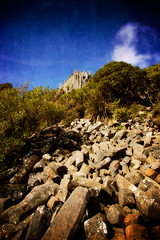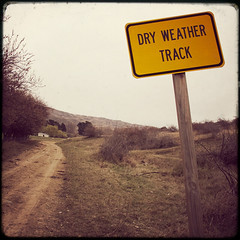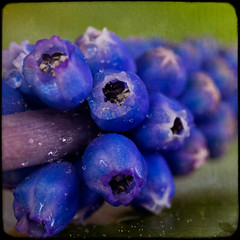Yesterday afternoon we decided to walk up to this local rock formation known as the Organ pipes.
The track is only a short distance from town but we haven't been for ages, not since the kids were little anyway and when I was walking up I remembered exactly why we don't go often, it's so steep!! The first part of the track is wooden steps and then there are rock steps , and after the initial very steep part it flattens out somewhat, well flatten isn't really the right word, I should say it got less steep.
The organ pipes when we got there aren't nearly as impressive as they used to be as there have been rock-falls (earthquake caused perhaps). The area is the site of a long extinct volcano and these basalt columns are the result of what is known as columnar jointing -something to do with the lava cooling at different rates and then cracking. Some of the columns are almost perfect hexagon in shape.
The track we were on continues right up to the top of Mt Cargill -the mountain that overlooks Dunedin. On our way back to the carpark we were passed by two obviously very fit guys running up -it made me feel exhausted just seeing them.
Monday, September 29, 2008
Monday, September 15, 2008
Sentries
Just north of Dunedin at Purakanui is the site of a Maori pa or fortified village known as Mapoutahi. The pa was sited on a small jutting peninsula just to the north of the Purakanui inlet. It has steep cliffs on all the seaward sides and is only accessible by a steep narrow track less than a metre wide which made it very easy to defend.
In the 18th century this lovely place was the site of a massacre. A chief named Taoka or Taonga came south from Timaru looking for revenge after the death of his son. They first laid siege (for 12 months) to Karitane pa, a few kilometres to the north but didn't gain entrance, so they turned their attentions to Mapoutahi, where after a siege of about 10 days Taoka and his warriors finally gained entrance and 250 people were killed, only one or two escaped by throwing themselves into the sea.
Today it is a peaceful place with a panoramic view of the area with little to remind you of bloodshed that occurred there.
Read the full story of the massacre Here
In the 18th century this lovely place was the site of a massacre. A chief named Taoka or Taonga came south from Timaru looking for revenge after the death of his son. They first laid siege (for 12 months) to Karitane pa, a few kilometres to the north but didn't gain entrance, so they turned their attentions to Mapoutahi, where after a siege of about 10 days Taoka and his warriors finally gained entrance and 250 people were killed, only one or two escaped by throwing themselves into the sea.
Today it is a peaceful place with a panoramic view of the area with little to remind you of bloodshed that occurred there.
Read the full story of the massacre Here
Tuesday, September 09, 2008
Dry weather track
This "track" leads to the Fraser Dam, an irrigation dam high in the hills near Alexandra in Central Otago. I haven't been there for years but when I was a child we would go there on occasion fishing. The trout in the dam had the reputation of being sneaky. Instead of putting your worm on the hook letting the fish catch themselves -the lazy method we used in the other dams we visited, with these fish you had to hold your rod waiting for the bite.
One of my earlier childhood memories was visiting this dam with my grandparents in their huge car -a vauxhall or dodge or something, it was curved and green and built like a tank. Probably the reason I remember this particular trip was that excursions like this with my grandparents and especially in their car were relatively rare, or maybe it was the lollies that we were given along the way. It's funny how you remember small snippets of time; in this case I remember grandma reaching from the front seat with a lolly, probably a barley sugar and I even remember unwrapping it and putting the paper in the ashtray in the back of the seat, this all happened somewhere near where I took this photo.
I doubt if my grandfathers' car would have made it to the dam these days, the road was fairly rough in places and I definitely wouldn't have wanted to be there when it was wet. The dam, when we got there was very low, but since it's not fishing season it didn't matter. We did find a walking track to a historic site with the intriguing name of Shek Harn further up the valley above the dam and will go back to explore when we have more time.
One of my earlier childhood memories was visiting this dam with my grandparents in their huge car -a vauxhall or dodge or something, it was curved and green and built like a tank. Probably the reason I remember this particular trip was that excursions like this with my grandparents and especially in their car were relatively rare, or maybe it was the lollies that we were given along the way. It's funny how you remember small snippets of time; in this case I remember grandma reaching from the front seat with a lolly, probably a barley sugar and I even remember unwrapping it and putting the paper in the ashtray in the back of the seat, this all happened somewhere near where I took this photo.
I doubt if my grandfathers' car would have made it to the dam these days, the road was fairly rough in places and I definitely wouldn't have wanted to be there when it was wet. The dam, when we got there was very low, but since it's not fishing season it didn't matter. We did find a walking track to a historic site with the intriguing name of Shek Harn further up the valley above the dam and will go back to explore when we have more time.
Monday, September 01, 2008
Spring
After a long damp winter spring has arrived here at last, or at least the calendar says it has. Our mornings are getting lighter and it's only a month until daylight saving starts again.The garden is finally getting dry enough to work, though the rain forecast over the next couple of days will set things back again.
These muscari or what I've always called match heads or grape hyacinths are among the first spring flowers in my garden, they form large clumps and their long straggly grass-like foliage can be a nuisance but their wonderful blue colour more than makes up for any shortcomings. I love their triangular shape and the spiralling pattern of the florets up the stem. They always look like miniature blue trees to me.
I've never particularly noticed their fragrance but they are supposed to smell of wet starch or plums depending on what reference you read, and have been used in the past to flavour rhubarb pies; not something I would be keen to try. The bulbs are poisonous.
These muscari or what I've always called match heads or grape hyacinths are among the first spring flowers in my garden, they form large clumps and their long straggly grass-like foliage can be a nuisance but their wonderful blue colour more than makes up for any shortcomings. I love their triangular shape and the spiralling pattern of the florets up the stem. They always look like miniature blue trees to me.
I've never particularly noticed their fragrance but they are supposed to smell of wet starch or plums depending on what reference you read, and have been used in the past to flavour rhubarb pies; not something I would be keen to try. The bulbs are poisonous.
Subscribe to:
Posts (Atom)



